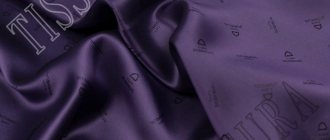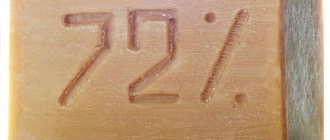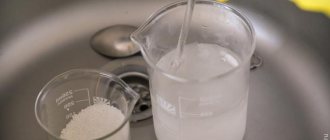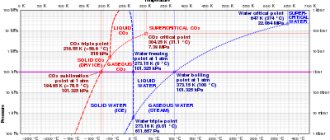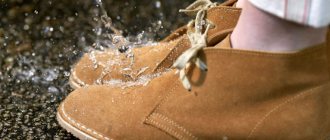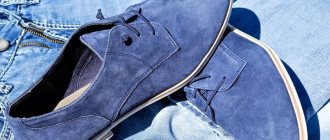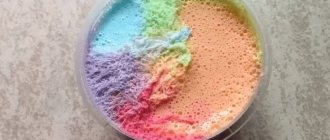Suede is a thin, soft fabric with a velvety, slightly fleecy surface. The fabric is made from the skin of cattle, and it has all the advantages of natural leather. Suede is extremely resistant to wear, retains heat excellently, is breathable and durable, and the product is difficult to tear.
The fabric is used for sewing outerwear, shoes, and various accessories. No less popular as a finishing material for upholstered furniture and car interiors. Its use is limited only by sensitivity to moisture: wet material loses its qualities and attractive appearance. It needs to be looked after carefully.
Suede - what kind of fabric is it, description
This is the result of tanning the skin of sheep, deer, and goats. The resulting material retains many of the qualities of leather, but at the same time becomes soft and light like fabric. It is so popular and practical that now, in addition to natural suede, the market offers a huge number of artificial substitutes that imitate the appearance of the material.
What are they made from?
Nowadays they make natural suede like this:
- raw skin of a goat, ram or pig is freed from wool and the upper dense layer - the flesh;
- the workpieces are impregnated with fats containing a minimum of acids;
- the skin is placed in impact grinders, where it is completely saturated with fat for 3–5 hours;
- the material is heated, re-soaked in fat and again placed in the grinders;
- then degreased in a solution of potash;
- the finished suede is dyed.
Artificial is obtained in ways depending on its type:
- Woven fabric is made like this: a base is made from microfiber fibers. The workpiece is processed on a machine where the threads are split into fibers of different lengths and diameters. The longer the splitting is carried out, the more uniform and beautiful the material is obtained.
- Non-woven is more affordable. It is made on a knitted basis - from natural or synthetic fibers, or on woven material. The base fabric is impregnated with soil, leveling the surface, and then treated with adhesive compounds. Electrified finely chopped fiber - viscose, polyamide, polyester - is sprayed onto the workpiece. To prevent contamination of the fabric and give it high moisture resistance, the material is impregnated with Teflon.
You can find out what kind of fabric polyester is here.
Texture and density: what it looks like
From the reverse side it looks like leather. The material is distinguished by a surface that is pleasant to the touch, fleecy on both sides, and is famous for its velvety feel and noble appearance. The density and thickness of the base somewhat affects the appearance, but not of the fabric, but of the products made from it. Thin suede lays in beautiful deep folds, is tight, and stretches easily. The thick one bends, but holds its shape much better.
Properties of this material
Real suede is an excellent material, equally suitable for clothing and shoes. Widespread use is due to its qualities:
- the velvety and soft surface is pleasant to the touch and looks like natural material;
- durability and wear resistance;
- resistance to fading;
- Teflon coating prevents dirt from penetrating into the fabric;
- does not accumulate static electricity;
- abrasion resistance, which makes it possible to produce upholstery for furniture;
- uniformity of color;
- absence of kinks, scratches and other defects inherent in natural suede.
For information about which fabric is best suited for a sofa cover, check out the link.
If the back side is similar to the front side or just leather, then this means that this is real material. If it is woven or smooth, it is a sign of a substitute.
Natural suede has disadvantages:
- Once wet, the fabric loses its quality and appearance;
- does not have a dirt-repellent effect;
- fabric products are salted.
Advantages and disadvantages
This artificial fabric has significantly more advantages than disadvantages. Let's look at everything in order.
Pros:
- As furniture upholstery, it is equally good for any interior style, be it classic or avant-garde. Its versatility is also evident in the successful use of suede both at home and in the office.
- Increased resistance to deformation and abrasions is another advantage of suede upholstery. Such sofa clothing will not crack or stretch under increased load, which its natural counterpart cannot boast of.
- The material does not accumulate static electricity.
- Artificial furniture suede has the same density throughout the entire perimeter, unlike natural one.
- The fabric is resistant to direct sunlight.
- This upholstery does not stick to the body.
- An interesting property of artificial suede for furniture: it gives warmth in winter and coolness in summer.
- The same goes for suede clothing. The skin in such clothes breathes.
- Faux suede is easier to clean thanks to the Teflon impregnation with which they are treated.
- This material looks no less aesthetically pleasing and attractive than the real thing. Its iridescent velvety surface attracts the eye.
Minuses:
- Fabric has limits. For example, it does not stand up to being used as a scratching post. Keep animals away from this upholstery.
- Light-colored material tends to get dirty quickly. The problem can be solved either by frequent cleaning or by a removable cover.
- Caring for faux suede is not easy. This material does not tolerate high humidity. Only dry cleaning or a minimum of water (solutions of ammonia or vinegar) is allowed.
Kinds
There are 9 types of material, both natural and artificial:
Natural type
Real suede is delicate, soft and elastic. Its base is leather, so a fabric base indicates a fake. The fabric is difficult to tear, it is durable and retains its attractiveness throughout its service life.
For natural suede, uneven color, scratches, and other minor defects are normal. Their absence indicates the synthetic origin of the fabric.
Thin
Differs from the usual thickness of matter. At the same time, the density of the material remains the same - 1.32 g/cm3. The fabric is used for clothing, since thin fabric gets wet more.
Velours
This refers to leather, not fabric. It is obtained from the skins of small animals or pigs, and spoiled skins with defects are used as raw materials. In this case, the outer side of the finished product is not the front, but the inner side of the skin. It is carefully sanded to obtain a low, uniform pile. During production, such leather is not treated with fat. Unlike suede, it is afraid of water, so products made from it are treated with silicone, chrome soap and other substances that provide water resistance. Read the main characteristics of brushed cotton fabric - drape velor in this article.
Double face double sided
Double front is a general name for double-sided fabrics in which both the back and front sides look like the front side. As a rule, such suede has a typical velvety surface on the outside, and fur on the inside. This option is used for warm outerwear and soft winter shoes - ugg boots, for example.
Find out what is the best insulation for a winter jacket here.
Synthetic
Suede-like material made on a non-woven base by sputtering. For the latter, synthetic fibers will be used - polyamide, polyester. This base provides the material with hypoallergenicity and greater lightness. The wear resistance of the fabric is also higher than the version based on viscose fibers.
Types of synthetic suede:
- textile;
- ecosuede;
- diving;
- Alcantara;
- plastic;
- upholstery
Reviews about the material:
Andrey: I like suede. My car seat upholstery is made from this. It looks very good and is easy to use. Upholstered a year ago, but it looks like new. I recommend it to everyone! Ekaterina: I love experimenting with clothes, mixing different styles and textures. Suede helps me a lot with this. I really love dresses and skirts, as well as all kinds of accessories. Many people are afraid to buy such products because they consider this fabric difficult to use... I don’t think so, if a stain appears, it can be cleaned with a damp cloth, and if washed, then only at 30 degrees, no more.
Application: where to use
Suede is a practical and beautiful material. Despite the cost, it is widely used:
Sew shoes for winter, spring, autumn
Natural suede is a lightweight and porous material. This ensures both the water permeability of the fabric and its ability to maintain temperature. Thanks to this quality, it is used for sewing summer shoes - shoes, sandals, and demi-season shoes and low shoes, and winter ones - boots. Suede shoes go well with almost any wardrobe item.
As you know, in rainy and dirty weather, suede shoes can quickly take on a sad look. Suede shoes and boots, of course, are more suitable for dry days, but they can also be worn in the rain - you just need to pre-treat the shoes with a good protective impregnation from a reliable manufacturer.
Clothing: knitted base, stretch, Alcantara, diving
Suede based on cotton materials or knitwear is necessary for sewing outerwear. Jackets, coats and jackets made from this material are soft and cozy, pleasant to the touch, and fit the figure well. Women's suits and skirts made of suede look great.
Cotton-based fabric is denser and holds its shape well, so it is better to make costume items from it. The knitted base makes suede soft and pliable. This material drapes well and fits into folds; dresses, skirts, and blouses are sewn from it. In this way, it is similar to woolen fabric, fabric for jackets and suits, which you can learn about in this material.
Upholstery products
Suede is an excellent material for accessories. Gloves, bags, scarves, belts, hats are sewn from it, and a wide variety of jewelry in ethnic style is made.
Suede fabric is very popular in furniture production. Due to its wear resistance and excellent appearance, it is used as upholstery for chairs, armchairs and sofas. Suede furniture will be appropriate not only in the apartment, but also in the office. However, in some cases, artificial suede is used for furniture upholstery.
Properties
Artificial perfectly imitates natural, but its cost is several times less. Its other advantages include:
- easy to clean, does not absorb dirt and water;
- does not fade under the influence of ultraviolet radiation;
- environmental friendliness;
- a decent period of operation - it is difficult to scratch or stretch;
- wear resistance - retains its appearance for many years, does not wear out;
- uniformity of color and pile coating;
- velvety, pleasant to the touch.
Does not absorb water
Home care, features, how to refresh
It requires care, otherwise the fabric loses its properties. The material must be protected from water, dirt and dust. Special impregnations are used for this.
After treatment with water-repellent agents, you should not wear shoes or clothes for 24 hours.
How and with what to clean such distinctive material
Cleaning at home is done using a special plastic brush. This device allows you to remove dust and dirt, but does not damage the pile. Clean shoes, clothes, upholstery, performing movements only along the direction of the pile.
A prerequisite: the product can be cleaned when it is completely dry. Otherwise, the pile is quickly wiped off. Refresh the appearance of shoes and clothes and get rid of creases: to do this, just hold the product over a container of hot water, and then brush it with a brush to restore the pile.
To clean off greasy stains or deeply ingrained dirt, resort to additional means:
- Half a teaspoon of baking soda is diluted with 100 ml of milk, then a napkin is moistened in the resulting solution and the stains are wiped. After removing them, wipe the area of fabric with a clean damp cloth and dry it.
- To remove a greasy stain, use a mixture of equal parts of starch and ammonia. After cleaning, the product should be wiped with an important cloth.
- A newly planted greasy stain is removed with a mixture of talcum powder, tooth powder and gasoline.
- Light suede is cleaned at home with a mixture of talc, turpentine, milk and magnesia - in equal proportions. The composition allows you to remove both deeply ingrained dirt and grease.
- Fresh dirty stains can be removed with a regular eraser.
How to wash (dress, curtain, skirt, raincoat)
Aqueous solutions can also be used for cleaning if the area of contamination reaches a large size:
Stain remover
Special shampoos can be safely used for cleaning. A sponge or napkin is moistened in the shampoo solution, wipe the contaminated areas, and then repeat the procedure using clean napkins. This method is convenient when cleaning car interiors or upholstered furniture.
Good washing powder
A regular solution made from washing powder or laundry soap is less effective. However, for shallow but extensive contamination, this is sufficient.
Cleansing with warm water
In simple cases, it is enough to moisten a napkin with warm water and then wipe with a dry, preferably silk, cloth. After “wet” cleaning, the product should be completely dried.
How to wash suede items, how to properly clean and wash them
Covers, clothes, shoes and accessories are washable. Moreover, for an artificial substitute this option is preferable. How to wash the material depends on the type of fabric and contamination:
Hand wash (can be washed gently)
Shoes or clothes are soaked in soapy water (water temperature 35-40 degrees). Wash without making any effort so as not to wrinkle the fabric. You should absolutely not wring it out; you can blot it with a towel and hang it on a hanger to dry. To prevent smudges on things, you should periodically blot them with a towel. There is no need to spoil the product, but if creases do form, do it from the inside out through the fabric. This washing method is also acceptable for corduroy.
Automatic washing, cleaning (wash at home)
Possible for light and sports shoes and clothing made of artificial suede, since the latter does not form creases. For washing, use powder for delicate fabrics, without bleach. Washing mode – gentle or delicate.
After machine washing, the shoes are dried by filling them with dry newspapers so that the sneakers or sandals do not lose their shape. Clothes are placed on hangers to dry.
What is faux suede called?
Non-natural suede is also called eco-suede. This is not quite the correct name, but manufacturers often use these words as synonyms. All eco-suede is an artificial material. But not everything artificial is eco-friendly. It is understood that if materials that do not harm the environment were used to produce the fabric, then the material is eco-friendly.
This type of material is much easier to care for than its woven counterpart.
All other products are correctly called non-natural suede elements. The material used for upholstery can also be called Alcantara. Some manufacturers may present this as a new product among upholstery products. But in essence, this is ordinary synthetic suede. Therefore, you should pay attention not to the name of the material, but to the method of its manufacture, type.
A fabric that stretches (elastic or not)
Natural suede stretches only within the limits that the skin allows. This is a lot, but such a material cannot be called elastic. To obtain such properties, a certain kind of artificial substitute is used.
The problem is solved like this:
- If viscose or polyester knitted fiber is used as a base for spraying, the stretchability of the material increases noticeably.
- You can increase elasticity by adding lycra and stretch to the non-woven base. 2% spandex is enough to provide the material with high elasticity.
- The woven material can be made elastic if microfiber is pre-made with a minimum diameter.
It is impossible to make natural leather more elastic than it already is.
Advantages and disadvantages of velor
The external characteristics of this material allow you to create beautiful, aesthetic things. Clothes made from velor are very comfortable, and a velor sofa looks luxurious and decorates any interior.
So, the positive properties of velor:
- the material is very practical - it does not wrinkle and warms well;
- the fabric is warm, soft and pleasant to the body;
- looks expensive and aesthetically pleasing;
- holds its shape and allows air to pass through, allowing the skin to breathe;
- safety – does not rub, does not irritate the skin and does not cause allergies;
- absorbs moisture;
- does not hinder movement;
- perfectly preserves the color of the fabric;
- durability - the material does not lose its properties for up to 3 years.
Disadvantages of the material:
- high cost of velor;
- dirt is easily absorbed into the fabric;
- accumulates dust, collects foreign lint, hair and fur.
The better the quality of the pile thread from which velor is made, the higher the quality of the fabric itself. The material is an elegant combination of softness and strength.
The difference between suede and leather, flock and nubuck
How suede differs from other materials is easy to understand:
- Leather is the raw material. Which ones have a smooth or matte surface, there is no lint at all.
- Nubuck – chrome tanned leather. The resemblance to suede is given by the processing: sanding with calibrated sand. Nubuck is as durable as leather and resistant to moisture, more than suede.
- Velor is a semi-leather material. It is distinguished by thick and long pile. Velor is weak, gets wet and needs protection.
- Flock - this material has a characteristic short pile on the front side. It is obtained by spraying finely chopped wool or cotton fibers onto a fabric. Flock does not withstand moisture and gets wet. This is an ordinary fabric with a pile similar to velvet and does not possess any of the properties of leather inherent in suede.
Making velor
Velor bag
Velor is a fabric with soft shiny pile on the front side of the fabric. The historical name of the fabric is velours - “velvet” translated from French. However, real velvet has much shorter pile. This material is made from natural wool, sometimes with the addition of cotton, silk or synthetic fibers (polyester and lycra).
There are two ways to make this material.
- Two-layer velor is a complex weave of threads. They are grouped into pairs that form two bases. Then two independent matters are connected to each other with a special thread. As a result, the material is cut between the bases and fabrics with a smooth back and a fleecy front side are obtained. This type of fabric is also called cut fabric.
- Rod velor is distinguished by its particularly thick and soft pile. Additional fibers are woven into the woven base, which are then pulled into loops with rods and cut. The second name for rod velor is looped.
Different manufacturing methods and composition allow you to create different types of velor:
- cotton – consists of 100% natural cotton (a small percentage of synthetic fibers is allowed);
- drape velor is a thin, warm material made from the best merino wool with satin weave;
- velor-velvet - a material with a pile of viscose or silk on a crepe fabric;
- furniture - thick elegant fabric;
- jacquard - characterized by a special weave of threads;
- automotive velor is a reinforced durable fabric with special impregnation against dirt.
The velor pile can be:
- smooth (in one direction throughout the entire fabric);
- shaped (multidirectional fibers form a non-uniform pattern);
- embossed (the fibers are specially placed in the form of a pattern).
Velor
According to the method of dyeing, velor can be:
- plain painted (plain color);
- printed (with a colored pattern).
How to distinguish real from fake (eco-suede/eco)
In appearance, artificial and natural suede can be similar. To distinguish a fake from an original, you should pay attention to the distinctive features:
- If you run your hand over the suede, the pile changes direction and slightly changes the shade. This does not happen with faux suede.
- The reverse side resembles leather, that is, it has a rough or silky surface. Smooth polymer is a sign of a substitute.
- Natural correct suede does not have perfect color uniformity. The shade (color: red, white, black) on the sleeve and on the collar may differ (the difference will be visible).
- It is even easier to determine which is warmer - a product made from real suede or artificial one: natural fabric heats up in the hand.
- When the material is compressed, creases remain, which are then straightened out. No creases form on artificial material.
- If you press on the toe of the shoe, a network of wrinkles will appear on the suede, which then straightens out. Large creases appear on artificial leather, which last longer.
- If you drop water on natural suede, it will partially absorb the water and darken. With artificial water it will simply drain.
Using these and a number of other characteristics, you can distinguish suede from artificial suede.
You should not set fire to suede fibers to determine the naturalness of the material by the smell and color of the flame. Modern fakes completely imitate the desired smell.
What is better to choose
Suede or velor, which is better to choose, depends on what kind of product is purchased and for what occasions. When choosing boots, bags, gloves, you should give preference to more expensive suede products. They will last longer. In addition, suede items are warm and practical, although not suitable for everyday wear in the city.
Elegant boots or gloves made of velor can be chosen only for “going out” occasions. Upholstering a sofa and other pieces of furniture in velor is a good option. But even in this case, the capriciousness of the material should be taken into account.
conclusions
- Suede is a double-sided eco-material obtained (made) from the skin of cattle by removing the flesh, impregnating it with fat and polishing.
- Natural suede has an exceptional feature: wear resistance, practicality, excellent heat retention and retains a wonderful appearance for decades.
- Natural fabric is expensive. For sewing shoes and clothes (sew/sew a raincoat for the winter, curtains for the home) they often use artificial ones on a fabric or non-fabric basis.
- There are 9 types of material. This allows the fabric to be used for sewing clothes, shoes, bags, gloves, furniture covers, and car interior trim. Velor is one of the varieties of Aegis furniture fabrics.
- Suede is a finicky material. Products made from it should be looked after: it is important to carefully wash the dress, wash the shoes.
Velor and suede upholstery
Dense, beautiful material looks very attractive as furniture upholstery. Textile velor or suede will cost much more economically (and more humanely) than genuine leather.
Features of suede upholstery:
- high wear resistance allows the use of suede not only for home sets, but also for office sofas and armchairs that will be used by a large number of people;
- noble appearance, versatility - suitable for different interior styles;
- the material is used for dining room furniture because special treatment protects the fabric from moisture and food stains;
- the sofa upholstery will retain its original volume - the suede does not stretch or deform.
Velor upholstery:
- allows you to imitate exotic textures (leopard skin, zebra skin);
- sparkles original in the light;
- animal hair and dust can be easily cleaned with a vacuum cleaner;
- retains the shape of the product for a long time, even if the design is very complex (drapery, folds, decorative reliefs).
Use Cases
Most often, consumers choose suede as upholstery for furniture. If the sofa or chair in the room has lost its appearance, but the structure is strong and can be used, you can reupholster it. Today, performing such a procedure is easier and cheaper than purchasing new interior items.
Unique strength characteristics make furniture with such upholstery very durable.
In a textile store you can choose the appropriate fabric option. Many buyers believe that choosing material in a store is easier and more reliable than choosing a finished structure. The store provides the opportunity not only to examine the fabric from the front and back layers, but also to consult with the manager.
This fabric has much more advantages than disadvantages.
If you are purchasing a sofa, you should ask the seller to demonstrate the material. Typically, manufacturers attach a piece of fabric to the inside of the structure. And if you don’t focus attention on this, then consultants may simply remain silent about this feature.
When coated with a special impregnation, furniture suede becomes less dirty.
Faux suede is often used by shoemakers who specialize in handmade shoes. High-quality material will be in no way inferior in characteristics to natural material, while the cost of shoes and sneakers can be significantly reduced. The same parameters can be applied to the production of clothing.
Light suede requires special care.
Textiles easily show themselves in work. It is easy for the cutter to work with it. With proper care, a jacket or jacket will serve its owner for a very long time. Suede can be used as a decorative element. They can partially repair furniture and give old furniture a new look.
Rules of care
If faux suede products are regularly and properly cared for, they will retain their original appearance for a long time.
Suede clothing can be washed well with neutral detergents, gels and powders used for cleaning synthetic and woolen materials. It is better to wash by hand, using a sponge dipped in soapy water, laying the product on a flat surface. The temperature of the cleaning solution should not exceed 45 °C.
After washing, the product should be rinsed and blotted with a towel to remove excess water. It is better to hang dry clothes on hangers. To prevent water stains from forming on the bottom of the product during the drying process, blot the edges with a towel as they dry.
It is not recommended to wash clothes with a pattern on the front. If necessary, it can be cleaned with a soft brush dipped in soapy water, taking into account the direction of the pile.
If you need to use a stain remover, the product should not contain organic solvents. The stain removal operation is carried out using blotting movements.
Positive and negative aspects of the material
Faux suede is a beautiful and practical material that makes you fall in love with it from the first touch.
Advantages:
- huge range and low price;
- lightness and plasticity;
- tactile comfort.
Wearing clothes made from an artificial analogue is simply convenient, because it does not stretch, does not stretch, and does not wrinkle. Upholstery made of this material does not slip and does not wear out.
However, there are disadvantages to which, however, it is easy to adapt. If we put aside the instability to active damage (for example, to the claws of pets or punctures with sharp objects), the only drawback remains: the artificial version is difficult to care for.
Composition and production methods
At all times, natural suede was an expensive material, inaccessible to most. Only a few could afford to have several pairs of suede boots.
However, when people invented the first man-made fibers, everything changed. Very quickly, fabrics appeared in the public domain that imitated natural originals down to the smallest detail, both externally and in terms of consumer characteristics - substitutes for silk, leather and, of course, suede.
Just 30 years ago, screens for wide-screen cinemas were made from artificial suede, which was called pavinol. True, it was additionally coated with silver paint.
Modern artificial fabric is a high-tech material that is produced in large factories in very large quantities. It comes in two types, woven and non-woven, the latter is produced by spraying various types of artificial fibers.
On a woven basis
The highest quality, most durable, expensive artificial suede is made from microfiber. In production, the front side of woven microfiber is first fluffed to the smallest fibers using special brushes, and then polished to obtain a uniform, smooth surface.
Artificial suede on a woven base looks almost like natural, is resistant to damage, does not stretch, and is practically not deformed.
In addition, there is a technology for “gluing” two materials, a woven base and a polymer top, through a backing of glue and a protective solution. The result is a fabric of excellent quality, but a little denser and less breathable than the microfiber version.
By spraying
One of the fastest and relatively simple ways to obtain suede fabric is to spray polyester fibers onto a base, most often made of artificial material. Their length and density depend on the type of pattern of the final product.
The technology makes it possible to obtain fabric of any relief, with any decorative properties - even something reminiscent of tree bark, reptile scales or large-pore skin of rare animals.
Afterwards, the surface is sanded and treated with Teflon solutions for additional strength or water resistance. However, it still tears easily, is not very pleasant to the skin, and quickly loses its resistance to moisture.
Electrostatic
One of the most inexpensive types of ecosuede is made using an electrostatic field of high potentials (more than 50,000 V). A layer of polyvinyl chloride resin is poured onto a fabric base, most often tarpaulin, which remains sticky for some time. Finely ground viscose fiber is then applied in an electrostatic field, which adheres, polarizes, and then aligns perpendicular to the base.
The excess is combed out, and the resulting soft surface is additionally fixed with adhesive substances, dried, and painted. This suede fabric is cheaper than others, but due to the PVC base, it practically does not allow air and moisture to pass through and feels uncomfortable when in contact with the skin. It is used to make accessories, waterproof outerwear, and used for interior decoration.
Author:
Zakharova Nina Afanasyevna
I hope you like my article! If you find any shortcomings, just write to me about it! I am always ready for a conversation and will answer any questions you have, ask them!
